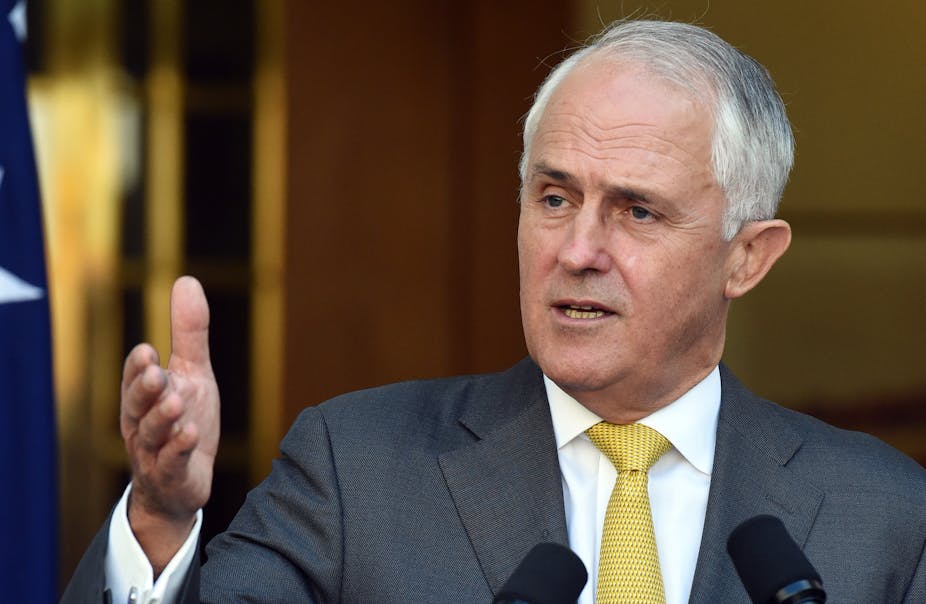The federal government has announced it will review the Safe Schools program, after conservative senator Cory Bernadi raised the issue in a partyroom meeting. He has accused the program, which aims to support lesbian, gay, bisexual, transgender and intersex students, of being a “radical program” that bullies children into complying with it.
Is this an example of Prime Minister Malcolm Turnbull – a known small-l liberal – caving in to the demands of the hardliners within his party?
Turnbull, like John Howard, stresses “the broad church” of Coalition politics. He has no choice. He must accommodate residual liberals, economic pragmatists and ultra-conservatives within his government and wrangle a viable consensus. His greatest threat is sniping from ultra-conservatives, who continue to champion Tony Abbott.
Defining ultra-conservatism
Ultra-conservatives are trenchant advocates of the status quo. Intensely individualistic, their world is one of conflict in which enemies of “individualism” are always at the gates. Hence, they commit to strong leaders and authoritarian processes.
While advocating “small government”, they insist on tougher policing, militarisation of borders and citizen surveillance (including an interventionist security state). Their standpoint implies a hierarchy of civilisations: the context from which they speak is the end-point of history, superior to what went before and to any contemporary challenge. There is no place for relativism.
Until recently, ultra-conservatives were rarely evident in Australian parties of the right. Liberal politicians were wary even of the term “conservative”.
After federation, Alfred Deakin successfully denigrated free-trade activists as “conservatives” who stood in the way of the progressive liberalism he advocated. In response George Reid, the leader of the free traders, declared that it was a political trick:
There is no such party in Australia.
Until the 1980s, Coalition party leaders followed this lead.
That is not to deny the periodic eruption of ultra-conservative views: the populist Kyabram Movement (1901) demanded retrenchment of the liberalism of urban elites (foreshadowing the One Nation Party of the 1990s).
In the mid-1930s, the secret “New Guard” army prepared to mobilise against the left, and Eric Campbell proposed a fascist program for economic recovery. Wilfred Kent-Hughes, a nationalist politician, declared his sympathy for fascist views in 1933. But such views gained little traction in mainstream parties.
Ultra-conservatives in contemporary Australian politics
What changed to encourage some in the Coalition parties to adopt ultra-conservative views? There were four interrelated factors:
party change;
voter alignment waning and electoral volatility;
rapid economic reform and associated uncertainty; and
global political instability (with “wars” on terrorism and chaotic mass population movements).
The parties of the era of managed prosperity (1940s to the late 1970s) were undermined by the collapse of the Keynesian consensus in which all had invested. And their battles over the reform transition undermined trust in parties.
For parties of the right, the destruction of Deakin/Menzies-style “small-l” liberalism, with the defeat of “wets” by economic “dries”, disenfranchised a proportion of the party base. This was one catalyst for the broken alignments to come. The narrower individualism of the economic pragmatists was also more conducive to an ultra-conservatism which the need to reach consensus within a “broad church” had earlier kept in check.
As “rusted-on” support (on both sides) eroded and electoral volatility increased, the parties relied on professional evaluations of opinion to guide policy and win votes. They torched their philosophical rationale and further alienating one-time supporters.
But the “true believers” who remained were more intensely partisan, clinging to beliefs that were increasingly out of step with the broader electorate — and more accommodating of ultra-conservative opinion. Thus, for instance, recent polls show that while majority public opinion favours legalising same-sex marriage marriage and action on climate change, only a minority of Coalition MPs share those views.
Much is said about the pros and cons of economic reform from the 1980s on, but clearly it did, as journalist Paul Kelly argued, mean “the end of certainty”.
And just as we were confronted with all that the “risk society” entailed for individual economic security, we were faced with other threats inextricably linked with modernising globalisation: the emergence of reactionary fundamentalist terrorism and large-scale population movement.
These challenges are extraordinarily complex, demanding resort to expert knowledge and sophisticated leadership. The ultra-conservative response, however, is to deny complexity, to appeal atavistically to a lost golden age and for strong leaders who will “shirt-front” aggressors, expunge critics within, and close the borders against culturally disparate invaders.
This intolerance of complexity and ambiguity is echoed in their response to other collective action problems such as climate change.
Turnbull’s challenge
Most of us, most of the time, are not prey to such premature cognitive closure. Yet research shows that, as uncertainty increases and understanding eludes us, the strong leader who cuts through the dithering, negotiation and compromise of conventional politics with decisive “answers” gains traction.
Howard’s implementation of the security state and Abbott’s “stopping the boats” were exercises in just such leadership. The tenets of ultra-conservatism had found a footing in their party.
But how to contain the rest – the residual liberals and many in the electorate who recognise uncertainty but remain unpersuaded that apocalypse is at hand? Abbott paid insufficient attention to this and, concentrating on his unrepresentative partisan base, lost public support.
Turnbull immediately turned the tide by speaking for a broader liberal constituency. Now, to avoid provoking an ultra-conservative insurgency within the Liberal Party, he is back-peddling on the policies that would deliver on his promise. Whether a liberal can manage all the forces within his party will be one of the greatest tests for Turnbull as prime minister.

